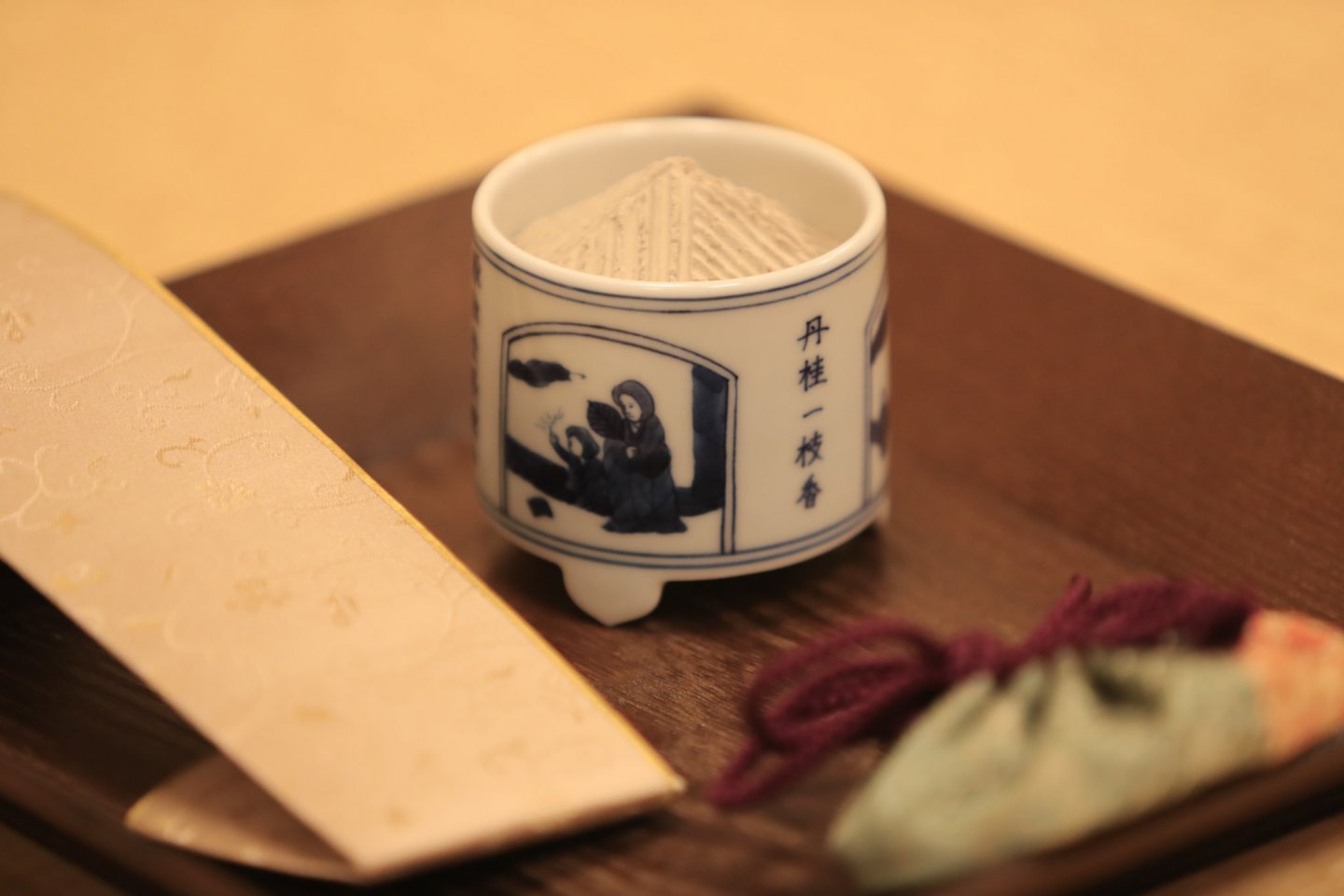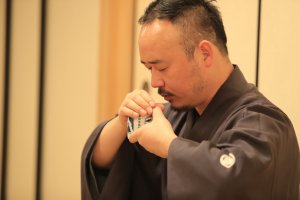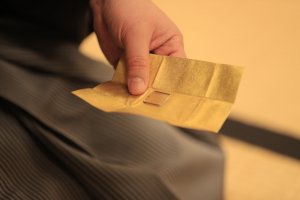It’s a rainy afternoon in late December, but the tatami room in the Sugekari Park in Meguro, a short walk from the Hibiya line’s Daikanyama station, is dry and well-lit. At the invitation of a business associate, I’m here to participate in an incense workshop sponsored by a local college.
Souhitsu Hachiya, the 21st successor to the Shino School of Incense, sits seiza, the traditional kneeling position, as he describes (through an interpreter) the history and culture of kodo – the Way of Incense. The other participants – students from various Asian nations, a married couple from India, and a few Tokyoites – seem to know as little as I about the subject. Mr. Hachiya and his forebears have dedicated themselves to this practice for over 500 years.
Guessing Games
Among other things, Mr. Hachiya tells us that noblemen and courtesans of ancient Chinese dynasties once enjoyed guessing games using incense, a diversion also mentioned in Murasaki Shikibu’s thousand-year-old novel Tale of Genji; that the Way of Incense, like its closely related, younger cousin sado (the Tea Ceremony), is evolved from these older traditions and pastimes, but is now more akin to the meditative discipline of Zen; and that the rare incense woods used in kodo, and by the Shino school in particular, are endangered, and to be treated with the greatest respect.
Better to Listen
At one point Mr. Hachiya poses a question: “Do you believe that man can converse with the natural world?” Making eye contact with each of us, he seems to apprehend our thoughts, and smiles slightly. In kodo, he continues, it is understood that nature is listening to us.
I like this man’s understated, well-measured thoughts. There is a gravitas about him, and I wonder if it comes from the weight of so much tradition (or is it the aura of his crested kimono, and formal hakama leggings?) Yet he is youthful, self-effacing, clearly a man of our times.
He ends his talk by announcing that we will move to the next room for the second part of the workshop. I am reminded now of what he has mentioned several times – that one does not smell incense; one listens to it. Now we will have a chance to learn what this riddle means.
It’s time for a round of kumikoh – the ‘pairing of scents’.
Mind and Fog
My place on the tatami mat affords me a view of the garden. As I watch the wind scatter wet leaves over the stones, I feel my stomach flutter. No longer will I be a passive observer; it’s time to participate, to become a listener in an exercise of mindfulness.
One of Mr. Hachiya’s acolytes, a woman in white tabi socks and a winter kimono, places a nest of wooden writing trays on the mat. Each tray contains an ink stone, ink stick and brush. Atop it, in unwrapped gold foil, are a dozen folded pieces of washi paper. These accouterments are passed around the room, with each student taking a tray and a piece of mulberry paper.
As we add water to the stones, and grind the ink – just as calligraphers have done for thousands of years – Mr. Hachiya holds up a piece of the paper.
He shows us where to write our names, and how we will use the opposite side to write our guesses each time we have ‘listened’ to a scent.
As he continues – and as my ink, far too thin, bleeds like a fog over the paper – I try to focus on his words. He is explaining how each scent will be named.
Whose woods these are…
The natural world, and in particular the aspects of the changing seasons, are essential to the practice of the Japanese arts of refinement. It being December, our three scents will be identified by winter themes: frost, snow and ice. We will have just one chance to commit these so-named aromas to memory before the contest begins.
Mr. Hachiya urges us to sit comfortably. This is a workshop in mindfulness, not a meditation on the agony of seiza.
And so the first blue and white porcelain censer, containing the scent we will call frost, is passed around the room. We hold it in the left hand, and with the right hand cupped above, listen; we exhale to the left. We do this three times, before carefully placing the censer by the next person. We listen to the next censers – of snow and ice – in the same way.
An airy thinness
I will not attempt to describe the fragrances of the incense; suffice it to say, it is neither the temple joss nor the sandalwood you might expect. The small chip of wood isn’t burning, either. It’s heated over hot ash on a thin film of mica. There is no smoke, only fumes of a very discernible, complex character.
Yet the difference between the three is nearly unrecognizable to my untrained senses. This game, I realize, will challenge me in a number of ways.
Adding to the difficulty, Mr. Hachiya announces that there will be a random fourth scent, one that we will not sample. This wild card scent – should we be able to distinguish it from the others – we will call “moon.”
Feeling like a schoolboy caught unprepared for an exam, I let my eyes drift back to the shadowy garden. Mr. Hachiya tells us not to worry about details, such as how we hold or rotate the censers. Rather, he counsels, focus on listening.
Of emperors, shoguns and samurai
In his lecture, he mentions that there are some 70 schools of tea (sado), and ten times as many of flower arranging (kado, also known as ikebana), but only two of kodo. Nor does he suggest any rivalry between the Shino style and other school of incense, the Oie. He tells us that the Shino way was the one practiced by the samurai, adding that the fighting men had a custom of suffusing their armor with incense before going into battle.
The preferred incense woods of the Shino tradition are those of fallen aloeswood trees. Dense with resins, dug from the forests of Southeast Asia, these precious burls have been named since ancient times. One, a piece that drifted ashore in Japan’s Inland Sea some 1300 years ago, was given the name “Ranjatai.” It is still kept as a national treasure, rarely exhibited, with a storied history involving emperors and shoguns.
Neophytes in review
Our game of kumikoh is coming to an end. We have passed the censers around the room ten times, listened to the known aromas three times each, and the unknown once, and noted each of our guesses.
Mr. Hachiya announces the order of the scents, and we score our answers.
He asks if anyone has correctly guessed all ten. No one has. He asks for a score of nine correct, then eight. No one has guessed that many correctly. In fact, we learn that the best of us have identified just five. Mr. Hachiya then asks if anyone has correctly guessed the “moon” scent, adding that this is the most important to get right.
No one has.
Parting words
The workshop concludes with Mr. Hachiya’s reading of classical waka poems, one for each of the themes. As I listen to the sentiments and images of things eternal – frosty meadows, icy streams, winter stars, a glowing moon – I’m not sure I fully appreciate their significance. Yet the power of the images moves me nonetheless.
Minutes later I thank Mr. Hachiya, and the people who have assisted him. I share a few words with the other participants, and see in them what I feel in myself; that we are focused and refreshed, aware in a way we were not just two hours ago.
As I step into the chilly twilight, to return with my umbrella along the narrow, glistening streets to the cacophony of the sprawling metropolis, my mind is clear. I have much to think about, but for now, I am content to listen.
































